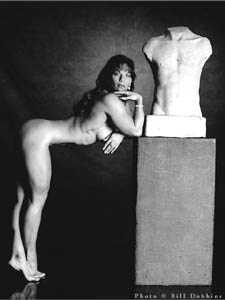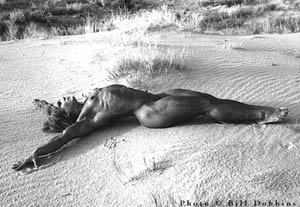WOMEN'S BODYBUILDING:
SOMETHING NEW UNDER THE SUN?
back
The thing that hath been, it is that which shall be; and that which is done is that
which shall be done: and there is no new thing under the sun.
Ecclesiastes 1:9
By Bill Dobbins
Change happened slowly, if at all, in the time of Ecclesiastes. But today change happens at such an incredible pace that most of us live in a perpetual state of culture shock.
It's clear that we live in an age
of miracles and transformation unlike any that has gone before. Nothing
new under the sun? Computers. Heart transplants. Gene splicing. Atomic
fission and fusion. In-utero fertilization. The information highway. In
the modern era, the sun never rises on the same world twice. Don't worry
about missing the revolution. There'll be another one along any minute.
 Nonetheless,
in all this chaos, certain ideas and concepts have persisted unchanged
over time. Take, for example, the image of the athletic male. The Greeks
would have instantly recognized and accepted the athletic male body as
portrayed by Michaelangelo in paint and sculpture or Arnold Schwarzenegger
in the movies. Even today, a well-built, muscular young man is said to
have the physique of a "Greek god." When it comes to the male
body, at least, plus ca change, plus c'est la meme chose. But
while there has been some consistency among cultures as to the ideal
configuration of the male body, the same has not been generally true
for the female. The acceptable image and behavior of women has often
been defined in terms of "femininity," which is essentially
a form of fashion. The culturally-endorsed image of women may be slender
or not, willowy or fleshy, coifed and appareled this way or that according
to the style of the age. But certain constants have tended to hold true.
For example, the female body has almost always been perceived in terms
of its sexual attraction to men. Explicit erotic images have been found
painted on the walls of caves by our prehistoric ancestors, sculpted
on the walls of the temples of ancient India, drawn on Chinese scrolls
and papyrus from the Egypt of the pharaohs.
Nonetheless,
in all this chaos, certain ideas and concepts have persisted unchanged
over time. Take, for example, the image of the athletic male. The Greeks
would have instantly recognized and accepted the athletic male body as
portrayed by Michaelangelo in paint and sculpture or Arnold Schwarzenegger
in the movies. Even today, a well-built, muscular young man is said to
have the physique of a "Greek god." When it comes to the male
body, at least, plus ca change, plus c'est la meme chose. But
while there has been some consistency among cultures as to the ideal
configuration of the male body, the same has not been generally true
for the female. The acceptable image and behavior of women has often
been defined in terms of "femininity," which is essentially
a form of fashion. The culturally-endorsed image of women may be slender
or not, willowy or fleshy, coifed and appareled this way or that according
to the style of the age. But certain constants have tended to hold true.
For example, the female body has almost always been perceived in terms
of its sexual attraction to men. Explicit erotic images have been found
painted on the walls of caves by our prehistoric ancestors, sculpted
on the walls of the temples of ancient India, drawn on Chinese scrolls
and papyrus from the Egypt of the pharaohs.
The female body has also been seen as a symbol of fertility as well as sexual attraction. Statues and drawings of females with ponderous, full breasts, swollen bellies and bulging thighs are common in so-called primitive tribal art from all parts of the world down through the ages. But one female body-image almost never seen is that of a woman with highly-developed, well-defined muscles. Big women, yes. Even strong women. After all, most women throughout history, and most men as well, have been peasant farmers, not aristocrats, and they have needed to labor long and hard to survive. But these labors never produced females with the kind of highly-developed muscularity that has virtually always been associated with the masculine physique.
This accounts in large part for why the emergence in the past few years of the modern female bodybuilding physique has had such power to shock and disturb. These women are not just big and strong---they are muscular, some extremely so, with a hard, well-defined development designed to have the maximum visual impact possible. As a result, the contemporary, muscular female represents a genuine revolution in human culture. There is no precedent for this phenomenon. Charles Gaines, author of Pumping Iron, and Pumping Iron II: The Women, has described the muscular female physique as a "new archetype." The development of the modern female bodybuilder has been indirectly but assuredly linked to the gains made by the women's movement. Until recently, it was not considered appropriate for women to be competitive athletes. It was considered unladylike and unfeminine for a woman to try too hard at athletic games. Young girls with an athletic inclination were called "tomboys," and encouraged to grow out of it.
Once women in general were allowed and encouraged to be athletes, it didn't take long for them to discover a rule that male athletes have known for some time---a stronger athlete is a better athlete, and the best way to develop the kind of strength needed to improve sports performance is with a program of progressive-resistance training. Once women discovered the weight room, the emergence of the hard-core female bodybuilder was only a matter of time. Today, the athletic female body has become increasingly accepted. Women nowadays not only excel at sports but are emerging as cultural icons in the process. Olympic stars like Florence Griffith Joyner or Nancy Kerrigan become household names. Female champions in sports like tennis and golf are sought after for commercials and product endorsements. But as fit and athletic as these women may be, the type of bodies they have are not perceived as extreme or unfeminine. They are not so muscular that they are consider freakish or grotesque.
The level of physical development of these female athletic stars is very different from that of today's elite female bodybuilders. Bodybuilders generally have more muscle, but it's the kind of muscle they display that is so striking, the degree of muscularity and definition they achieve, their ability to appear on a bodybuilding stage looking like some kind of New Age anatomy chart. Looking at photographs, people often think female bodybuilders are much bigger than they are. In actuality, female bodybuilders are often not much heavier than other women of the same basic size, but they do differ tremendously in body conformation and composition. Picture the difference between a 135 pound woman whose body is 30% fat, and a bodybuilder of the same weight with a relative body fat of 12% or lower.
An even more dramatic comparison
can be made between champion women bodybuilders and their male counterparts.
The biggest men are incredibly huge compared to the women. In recent years,
while the Mr. Olympia winner has been a massive 250 to 260 pounds, the
Ms. Olympia winner has weighed less than 150 pounds. (There are, of course,
bigger and heavier women in the sport but none so far has been a serious
contender in top professional competition.)
Nonetheless, while it can be surprising
how relatively small many female bodybuilders are, the degree of  muscularity and muscular definition
they achieve is well beyond what most untrained males in our society
will ever achieve. As a result, the advent of the world-class female
bodybuilder onto the scene has called into question many of our assumptions
regarding the physical capabilities of women and, indeed, the very nature
of the female body itself. For example, if it is so easy for at least
some women to create such impressive, muscular physiques, why has it
never happened before? And if women are capable of developing so much
more muscle so much more easily than we believed, why has the stereotype
of the woman as weak and helpless persisted for so long? What does this
new perception of the female body say about the level of physical development
of most women in our culture? Are women so much the "weaker sex" because
we've made them that way?
muscularity and muscular definition
they achieve is well beyond what most untrained males in our society
will ever achieve. As a result, the advent of the world-class female
bodybuilder onto the scene has called into question many of our assumptions
regarding the physical capabilities of women and, indeed, the very nature
of the female body itself. For example, if it is so easy for at least
some women to create such impressive, muscular physiques, why has it
never happened before? And if women are capable of developing so much
more muscle so much more easily than we believed, why has the stereotype
of the woman as weak and helpless persisted for so long? What does this
new perception of the female body say about the level of physical development
of most women in our culture? Are women so much the "weaker sex" because
we've made them that way?
Furthermore, if women who were evidently designed by nature to be strong---at least, stronger than we've allowed them to be---are kept physically weak and encouraged to believe that nature and evolution intended them to be weak, how does this affect their self-image? Their feelings of confidence and self-esteem? Their overall state of health and fitness? Their sexuality? The degree to which their bodies deteriorate with age? Their ability to function independently in daily living? Their quality of life?
Women nowadays have been at least partially liberated from stereotypes that put unwarranted limitations on their abilities and achievements in the past. But they are still imprisoned to some degree by an old-fashioned view of their bodies. The existence of champion female athletes in general and women bodybuilders in particular presents a serious challenge to that view. In fact, bodybuilding for women has become the basis of an entirely new examination, exploration and appreciation of capabilities and aesthetics of the female physique, as well as a direct challenge to many deeply held beliefs concerning "femininity," body image, and gender identification.